Overview
In the realm of software development, coding challenges are a common hurdle that many developers encounter. How can these obstacles be effectively addressed? This is where Kodezi comes into play, offering essential features that streamline the development process. Among the ten key aspects of Object-Oriented Programming (OOP) in Java, such as encapsulation, inheritance, polymorphism, abstraction, and interfaces, Kodezi enhances code maintainability, reusability, and security.
Furthermore, these features collectively contribute to a more efficient development experience. Imagine a scenario where code can be easily maintained and reused, significantly reducing the time spent on debugging and rewriting. With Kodezi, developers can experience improved productivity and enhanced code quality, allowing them to focus on what truly matters—creating innovative solutions.
In addition, the benefits of utilizing Kodezi are clear. By streamlining the development process, programmers can tackle projects with confidence, knowing that their code is secure and maintainable. So, why not explore the tools available on the Kodezi platform? The potential for efficiency gains is substantial, and the journey toward better coding practices begins with a single step.
Introduction
In the world of software development, coding challenges are a common hurdle that developers encounter. Object-oriented programming (OOP) serves as a foundational paradigm that enhances code organization, reusability, and maintainability. As developers strive to create robust applications, understanding the core principles of OOP—encapsulation, inheritance, polymorphism, and abstraction—becomes essential.
How can developers effectively navigate these complexities? Enter Kodezi, a tool designed to automate documentation and enhance productivity. With features that streamline the coding process, Kodezi empowers developers to tackle the intricacies of OOP with greater ease. By leveraging these principles, developers can foster high-quality software development while addressing the challenges faced in modern coding environments.
The benefits of using Kodezi include:
- Improved productivity
- Enhanced code quality
These advantages make it a valuable asset for any developer. Explore the tools available on Kodezi's platform and elevate your coding practices today.
Kodezi | Professional OpenAPI Specification Generator - AI Dev-Tool: Streamline Your OOPs Development Process
In the fast-paced world of software development, programmers often face significant challenges, particularly in effectively managing OOP features in Java. Kodezi emerges as an innovative solution designed to empower developers by streamlining these processes. Its Professional OpenAPI Specification Generator automates the creation of standardized API documentation, significantly reducing the time spent on documentation tasks. This not only allows programmers to focus more on coding but also enhances overall productivity.
By integrating Kodezi into your development workflow, you can enhance efficiency while ensuring that your programming adheres to professional standards. This integration facilitates the effective implementation of OOP principles, allowing developers to confidently navigate the complexities of OOP features in Java. Recent statistics reveal that automated documentation tools can boost programmer productivity by up to 30%. This underscores the critical importance of incorporating such solutions into modern development practices.
Imagine the difference it would make if you could confidently streamline your documentation process. With Kodezi, programmers can maintain high-quality code while enjoying the benefits of improved productivity. Are you ready to explore the tools available on the Kodezi platform and transform your coding experience? Kodezi not only simplifies your workflow but also empowers you to achieve excellence in your programming endeavors.
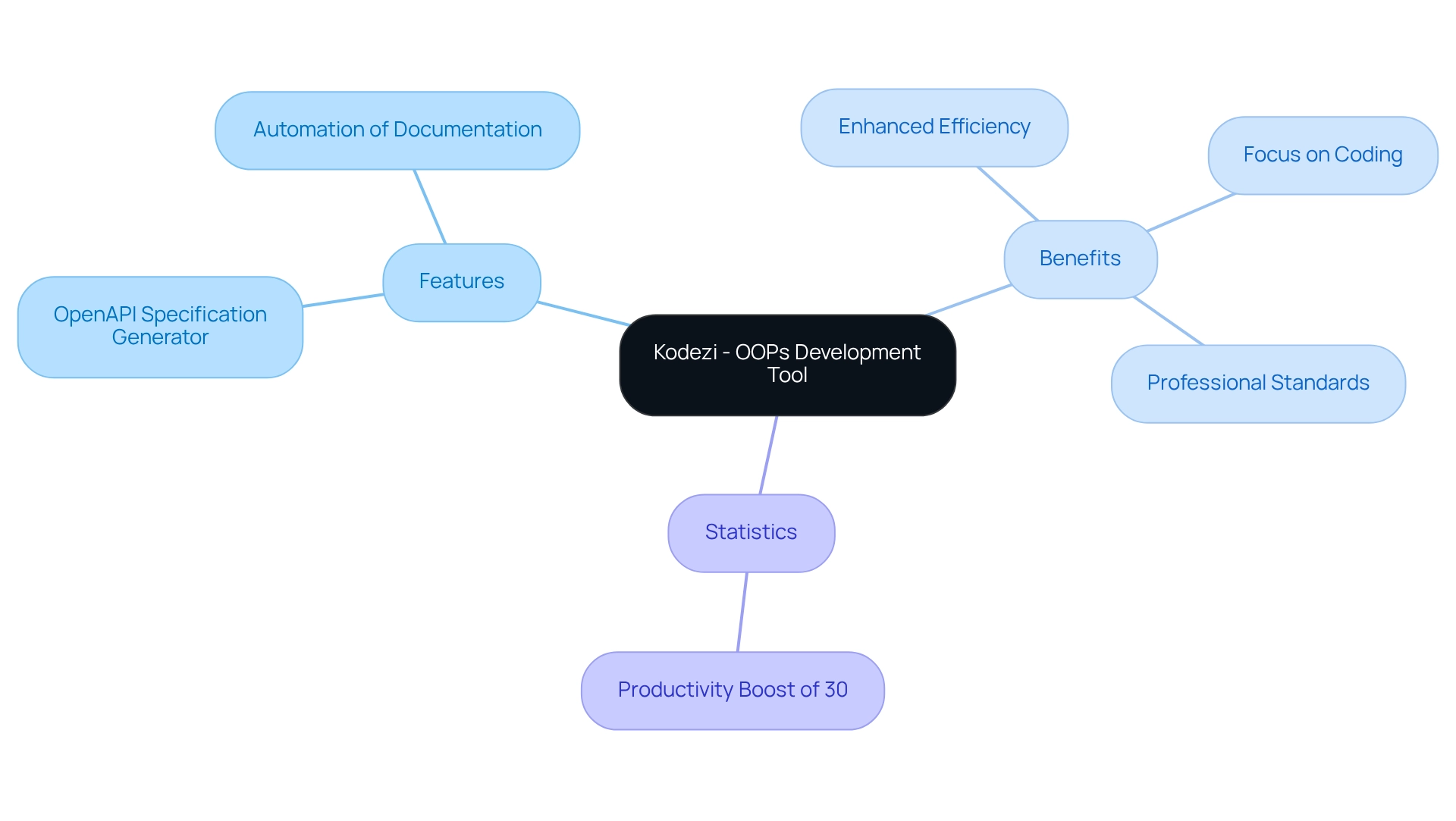
Encapsulation: Protecting Data and Enhancing Security in Java
In the realm of programming, developers often face significant challenges related to data security and maintainability. Encapsulation in Java emerges as a fundamental principle to address these issues. It involves bundling data (attributes) and methods (functions) within a single unit, typically a class, thereby restricting direct access to certain components of an object. This restriction is essential for safeguarding sensitive information. By utilizing access modifiers like private and protected, programmers can effectively control visibility, ensuring that data is accessed only through well-defined interfaces. This practice not only strengthens security but also greatly improves maintainability by reducing dependencies between components.
Why is encapsulation gaining traction among developers? The significance of encapsulation is underscored by the growing acknowledgment of its role in enhancing code quality and security. For instance, organizations that prioritize encapsulation practices report a marked reduction in vulnerabilities, contributing to a more robust software development lifecycle. Furthermore, with data breaches becoming more prevalent—44% of all social engineering incidents stem from phishing—implementing strong encapsulation techniques is vital for protecting against unauthorized access and ensuring data integrity.
To effectively implement data encapsulation, best practices include:
- Defining clear interfaces for data access and modification
- Utilizing getter and setter methods
- Regularly reviewing access modifiers to align with evolving security standards
As encapsulation remains a cornerstone of programming development, its role in improving both security and maintainability is vital, especially when the typical expense of a data breach can reach millions. By adopting these practices, programmers can create more secure and maintainable applications, ultimately leading to improved productivity and reduced risk.
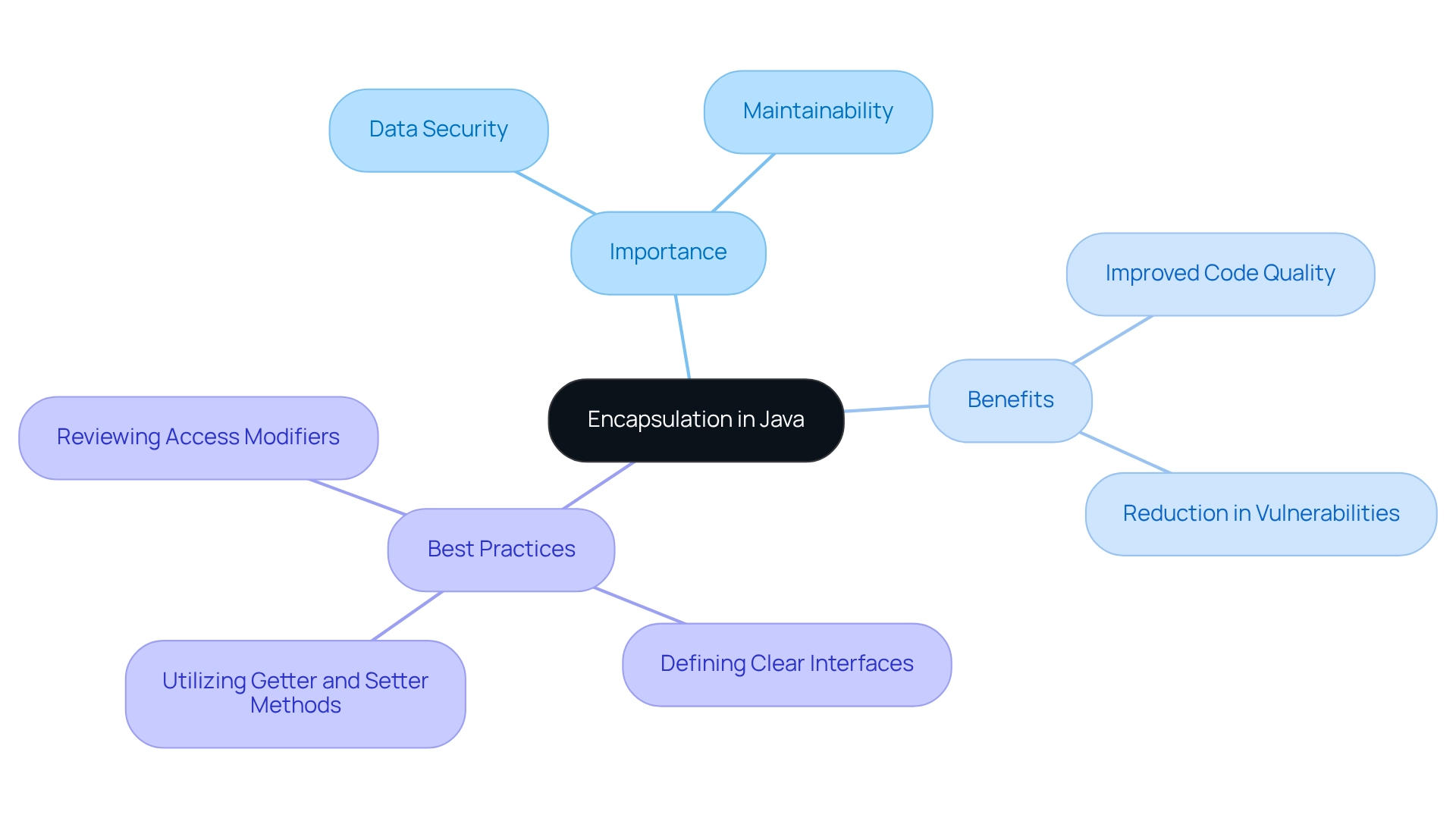
Inheritance: Leveraging Code Reusability in Java Applications
Inheritance in Java addresses a common challenge developers encounter: the need for reusability in code. By allowing a new entity (subclass) to acquire attributes and behaviors from a pre-existing entity (superclass), inheritance significantly streamlines the development process. For example, consider a type Animal; subclasses such as Dog and Cat can inherit shared attributes and methods while introducing their unique features. This not only reduces redundancy but also enhances organization, making it easier to manage and expand.
Furthermore, statistics reveal that roughly 10% of applications with adequate components exhibit cycles involving at least 1,000 elements. This highlights the complexity that can arise without efficient inheritance methods. A case study titled "The Role of Inheritance in Frameworks" underscores the importance of inheritance in popular programming frameworks, affecting application architecture and reuse practices. The findings indicate a higher-than-expected reliance on inheritance, with variations in usage between classes and interfaces.
In addition, expert insights affirm the advantages of inheritance as one of the key oops features in Java for reusability. Developers note that leveraging inheritance not only accelerates development but also fosters a cleaner codebase. By utilizing inheritance, developers can create robust applications that are easier to maintain and evolve. As Ewan D. Tempero observed, "In a vast collection of open-source software, merely around 50% of the classes in the Standard API are utilized, and approximately 21% of the methods are employed," emphasizing the significance of efficient inheritance strategies to enhance resource utilization.
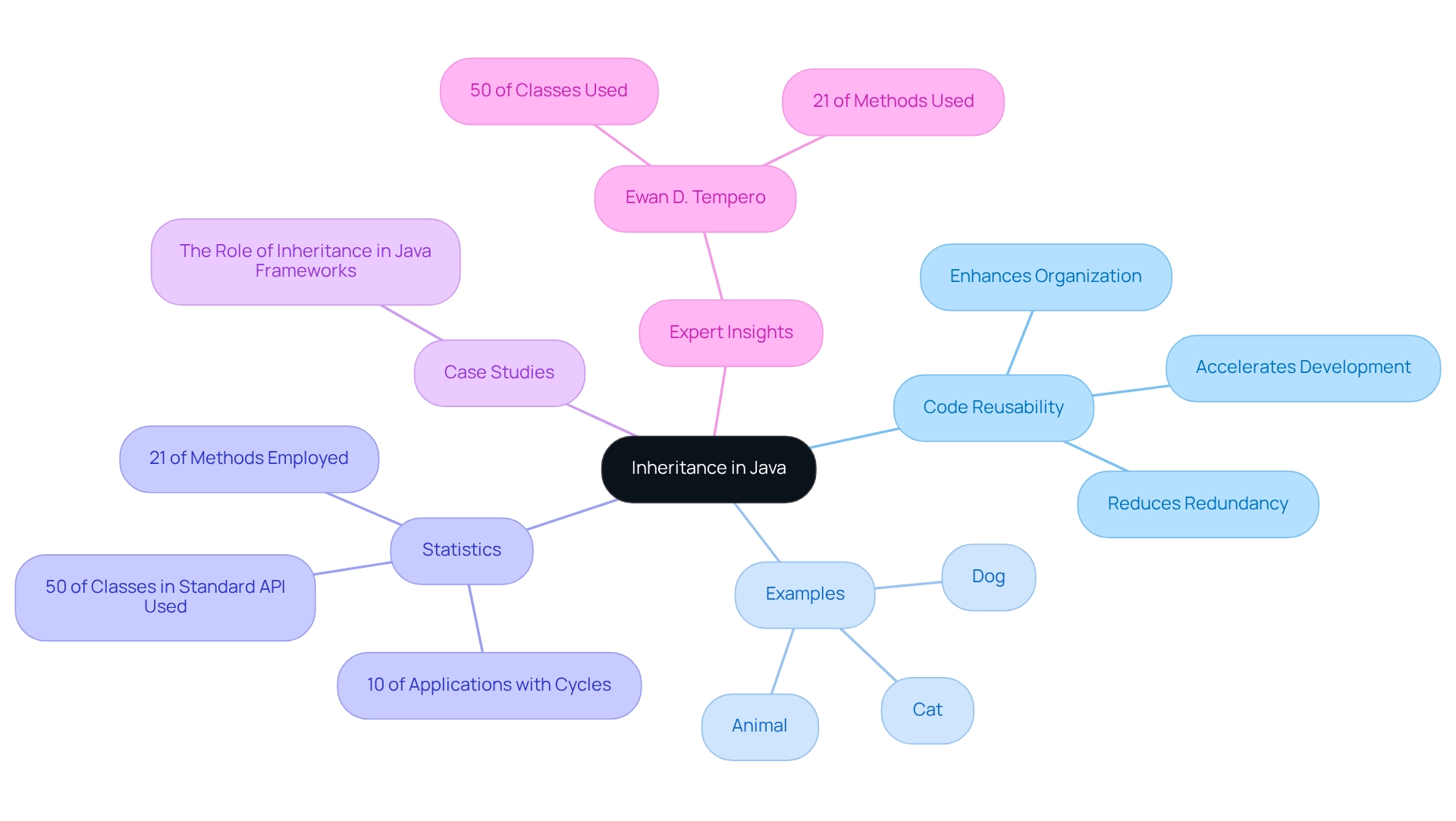
Polymorphism: Achieving Flexibility and Dynamic Behavior in Java
Polymorphism in Java addresses common coding challenges by enabling a single interface to represent different underlying forms, or data types. This powerful feature can be achieved through method overriding and method overloading. For example, consider a method named draw(): it can exhibit different behaviors depending on whether it is invoked on a Circle or a Square object. This flexibility allows programmers to create more universal and reusable functions, reducing the need for multiple method definitions.
Furthermore, the advantages of polymorphism extend beyond mere convenience. It significantly enhances maintainability and readability, simplifying the management of both small projects and large-scale enterprise applications. A case study titled "Polymorphism in Programming: Advantages and Applications" demonstrates its critical role in enhancing code reusability and simplifying maintenance. This highlights how developers can write more abstract and concise code, ultimately improving productivity and code quality.
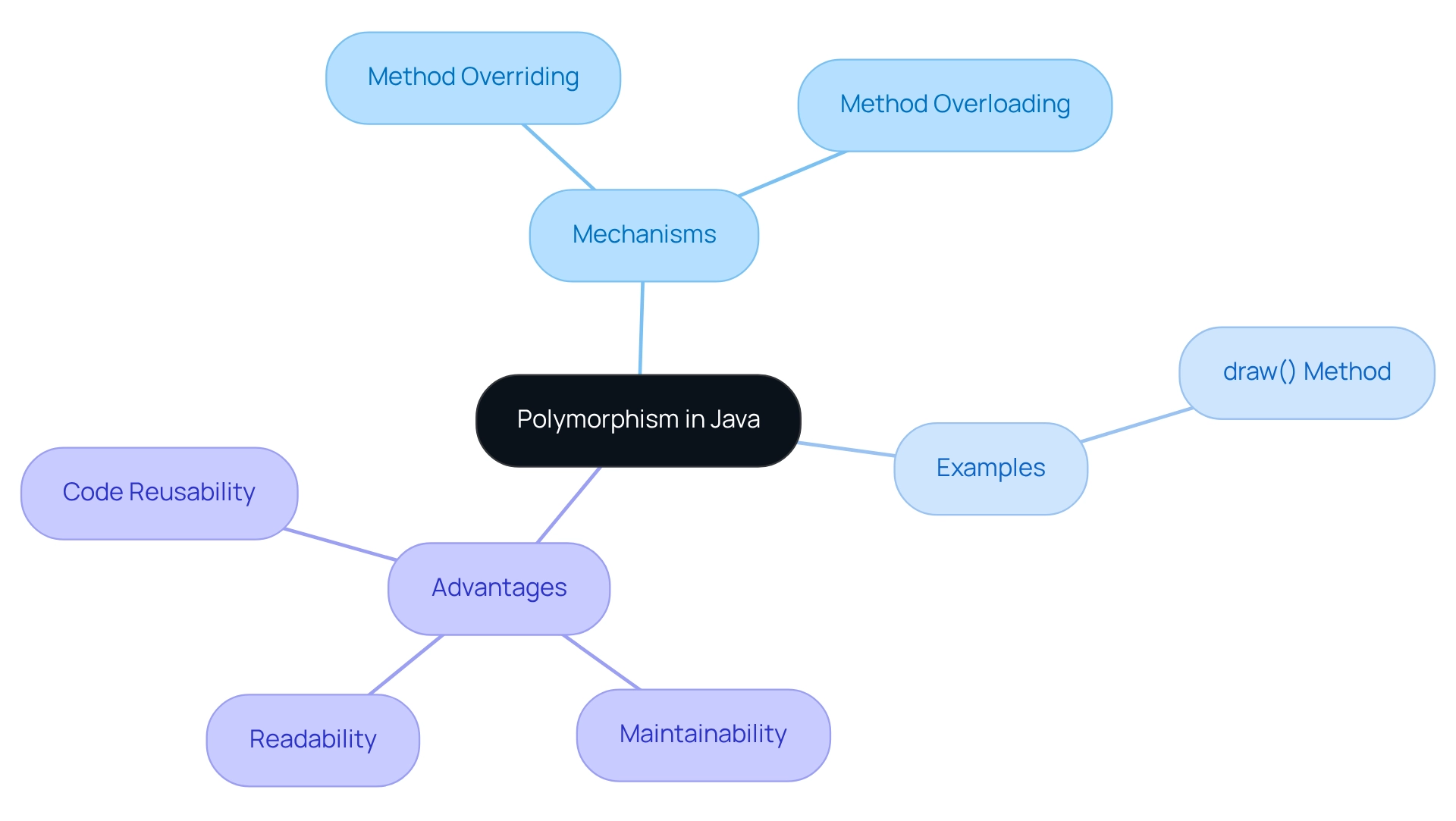
Abstraction: Simplifying Complexity in Java Programming
Coding challenges can often hinder developers, leading to frustration and inefficiencies. Abstraction in Java is a fundamental concept that helps by concealing implementation details while highlighting the essential features of an object. This is primarily achieved through the use of abstract classes and interfaces. By focusing on what an object performs instead of how it achieves it, programmers can streamline intricate systems and enhance readability. Furthermore, tools like Kodezi can significantly improve this process by automatically analyzing and correcting programming, allowing developers to concentrate on abstraction without getting bogged down by bugs.
For instance, consider an abstract class Vehicle that defines core methods such as start() and stop(). Specific vehicle types, like Car and Bike, can then implement these methods in their unique ways. This separation of concerns not only streamlines the codebase but also facilitates easier management and extension of the system. In addition, Kodezi’s AI-powered capabilities can assist in identifying and fixing issues within these implementations, ensuring that the abstraction remains clear and effective.
However, while abstraction is beneficial, it is crucial to strike a balance. Excessive abstraction can lead to increased complexity in programming, making it harder to understand and maintain. Developers must ensure that abstraction enhances clarity and efficiency rather than complicating the code. Kodezi can help mitigate these challenges by providing insights and corrections that keep the codebase manageable.
Current trends in programming emphasize the importance of using abstract classes and interfaces effectively, as they play a vital role in developing clearer and more manageable systems. Real-world applications demonstrate that when used appropriately, abstraction can lead to more efficient development processes and improved software quality. As Shailendra Chauhan, Founder & CEO at ScholarHat, notes, "Abstraction in programming is essential for creating scalable and maintainable systems." Additionally, Kodezi supports more than 30 programming languages and works with IDEs such as Visual Studio Code, rendering it a flexible tool for programmers. Statistics indicate that effective use of abstraction techniques in programming, supported by tools like Kodezi, can significantly enhance code quality and developer productivity.
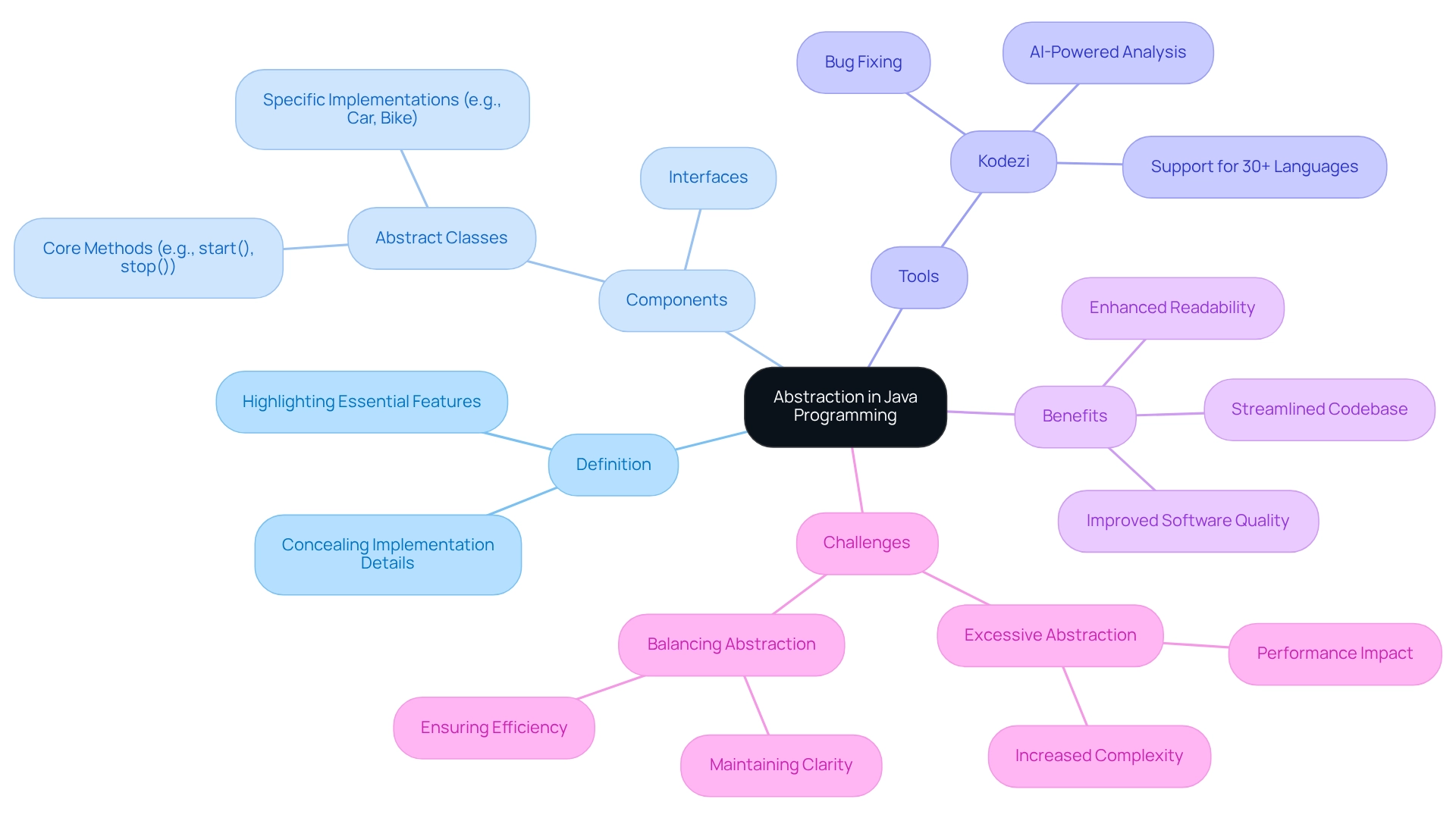
Classes: The Blueprint of Object-Oriented Programming in Java
In the world of programming, developers often face challenges when it comes to creating efficient code. In Java, a type serves as a crucial blueprint for constructing objects. It delineates a collection of attributes (fields) and behaviors (methods) that the objects derived from the type will embody. For example, consider a type Car, which may include attributes such as color and model, along with functions like drive() and brake(). By encapsulating information and behavior within these structures, Java not only promotes modularity and reusability but also empowers programmers to develop intricate applications more effectively. This approach leads to enhanced productivity and code quality, making it essential for developers to leverage the power of types in their coding practices.
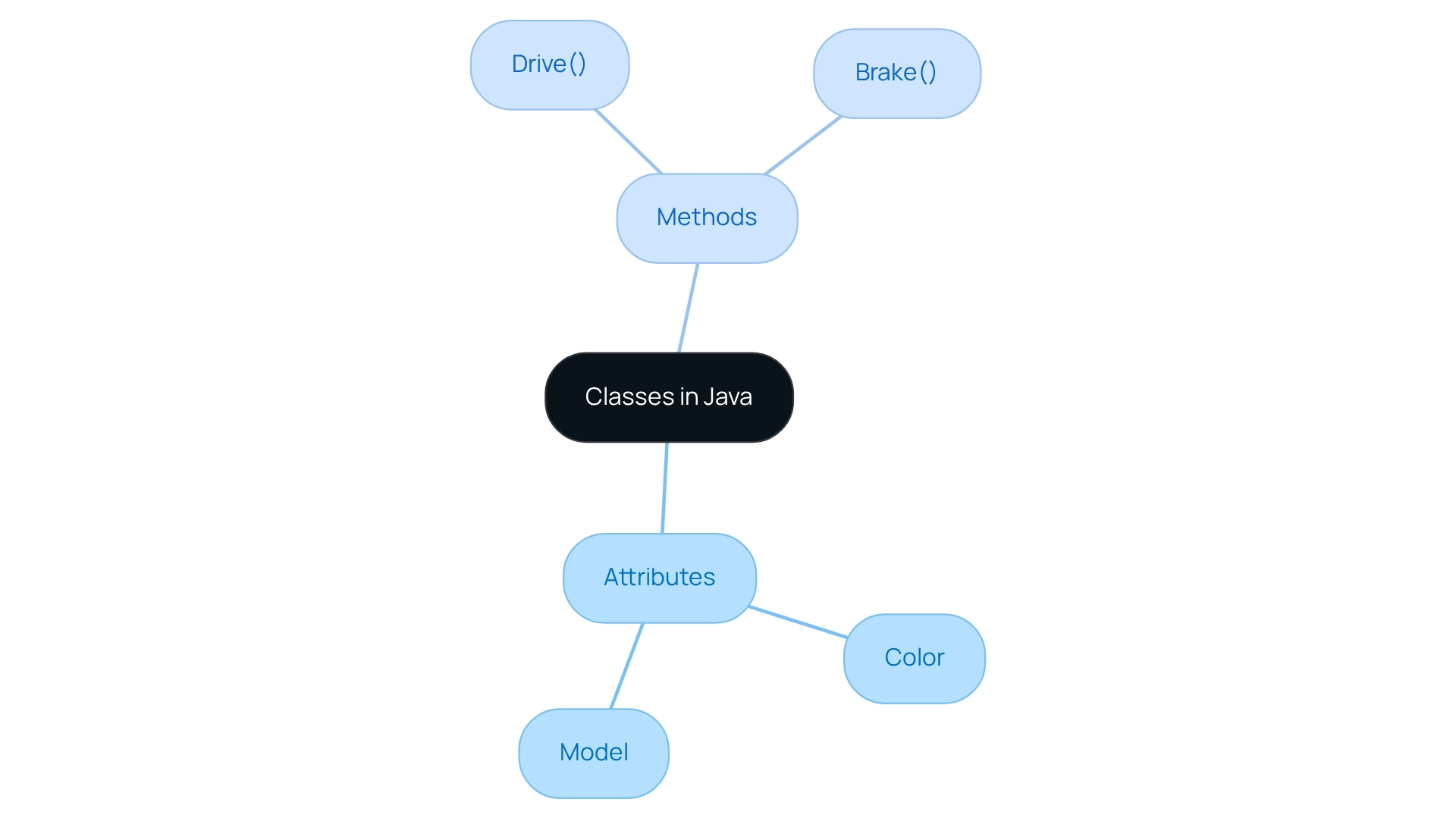
Objects: Real-World Representation in Java OOP
In the world of coding, developers often face significant challenges in managing complexity and ensuring code quality. In Java, an object serves as a particular instance of a type that encapsulates both data and behavior, highlighting the OOP features in Java as fundamental building blocks of object-oriented programming (OOP). Objects enable developers to represent real-world entities, facilitating a more intuitive modeling of complex systems. For instance, consider a class Dog; creating an object like myDog allows for the representation of a specific dog, complete with unique attributes such as name and age. This object can engage with other items and approaches, enhancing structure and making it more relatable and understandable.
Furthermore, the importance of objects extends beyond simple representation; they are vital in enhancing clarity and maintainability. By adopting OOP principles, programmers can enhance their coding efficiency by up to 50%, particularly when selecting the right collections based on access patterns. This efficiency is crucial in today's fast-paced software development landscape, where adaptability to emerging trends is essential for staying competitive. Tools such as Kodezi can significantly improve this efficiency by offering automatic programming corrections and bug analysis, enabling developers to concentrate on applying OOP concepts effectively. Unlike other tools like Copilot, Kodezi functions as an autocorrect for programming, assisting users in debugging and resolving coding problems rather than merely autofilling scripts.
In addition, real-world applications of OOP features in Java are abundant. For example, in a banking application, objects can represent accounts, transactions, and customers, each encapsulating relevant data and behaviors. This method not only simplifies programming but also incorporates OOP features in Java, mirroring real-world interactions and making the software easier to comprehend and handle. Kodezi assists developers in this process by optimizing programming and providing insights into potential bugs, thus enhancing overall productivity. Kodezi currently supports over 30 programming languages and is compatible with Visual Studio Code, with plans to support more IDEs in the future.
As the software development field evolves, the trend towards object modeling continues to gain traction. Developers are increasingly recognizing the importance of objects in creating relatable and understandable code. Various expert insights emphasize quality, clarity, and responsibility in coding practices. Case studies on object-oriented design further demonstrate the effectiveness of utilizing objects in programming languages, showcasing how they can simplify complex systems and enhance overall productivity, especially when paired with innovative tools like Kodezi.
Are you ready to explore how Kodezi can transform your coding experience? Discover the tools available on the platform and elevate your programming efficiency today.
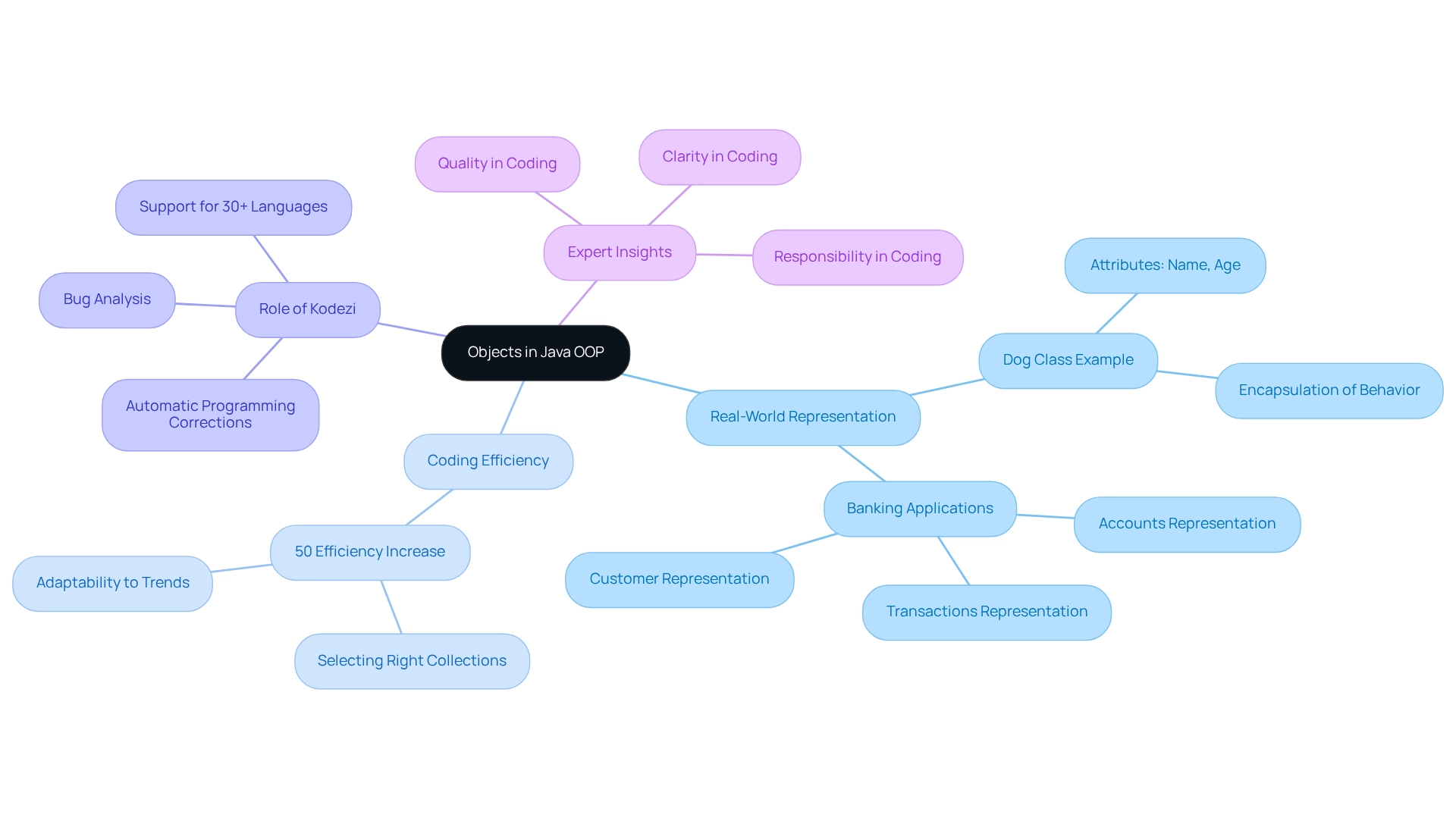
Interfaces: Defining Contracts for Flexible Java Applications
In the realm of Java programming, developers often face challenges related to flexibility and maintainability. An effective solution lies in the use of interfaces, which serve as reference types outlining a contract of methods that implementing types must fulfill. For instance, consider an interface Animal with a method makeSound(). Both Dog and Cat classes can implement this interface, each providing their own version of makeSound(). This enables polymorphic behavior, allowing the same method to be invoked on various types of objects, ultimately enhancing reusability and maintainability.
Furthermore, the function of interfaces extends beyond mere method declarations; they are essential for establishing contracts in programming applications. By utilizing interfaces, developers can create systems that adapt to change, as new classes can be introduced without altering existing code. This adaptability is crucial in modern software development, where requirements frequently evolve.
Expert opinions reinforce the significance of interfaces in achieving decoupling and flexibility. Pankaj Kumar aptly states, "We should always try to write programs in terms of interfaces rather than implementations," promoting a modular architecture that facilitates easier testing and maintenance.
Statistics indicate that a substantial portion of programming applications leverage interfaces, underscoring their prevalence in the programming landscape. Current trends highlight an increasing emphasis on interface-driven design, especially in large-scale applications where flexibility and scalability are paramount. For example, Java interfaces can extend other interfaces, further enhancing their flexibility and allowing for more intricate hierarchies.
In addition, interfaces play a pivotal role in fostering software reusability. By defining common behaviors, they enable developers to create multiple types that share the same interface, thus minimizing redundancy and improving collaboration among teams. However, it is important to recognize potential drawbacks, such as increased complexity and performance impacts, as discussed in case studies on the disadvantages of interfaces. Despite these challenges, the advantages of using interfaces—such as enhanced flexibility and decoupling—far outweigh the negatives, particularly with modern JVM optimizations that alleviate performance concerns.
In summary, interfaces are a cornerstone of effective Java programming. They facilitate the creation of flexible, maintainable, and reusable code structures that can adapt to the ever-changing demands of software development.
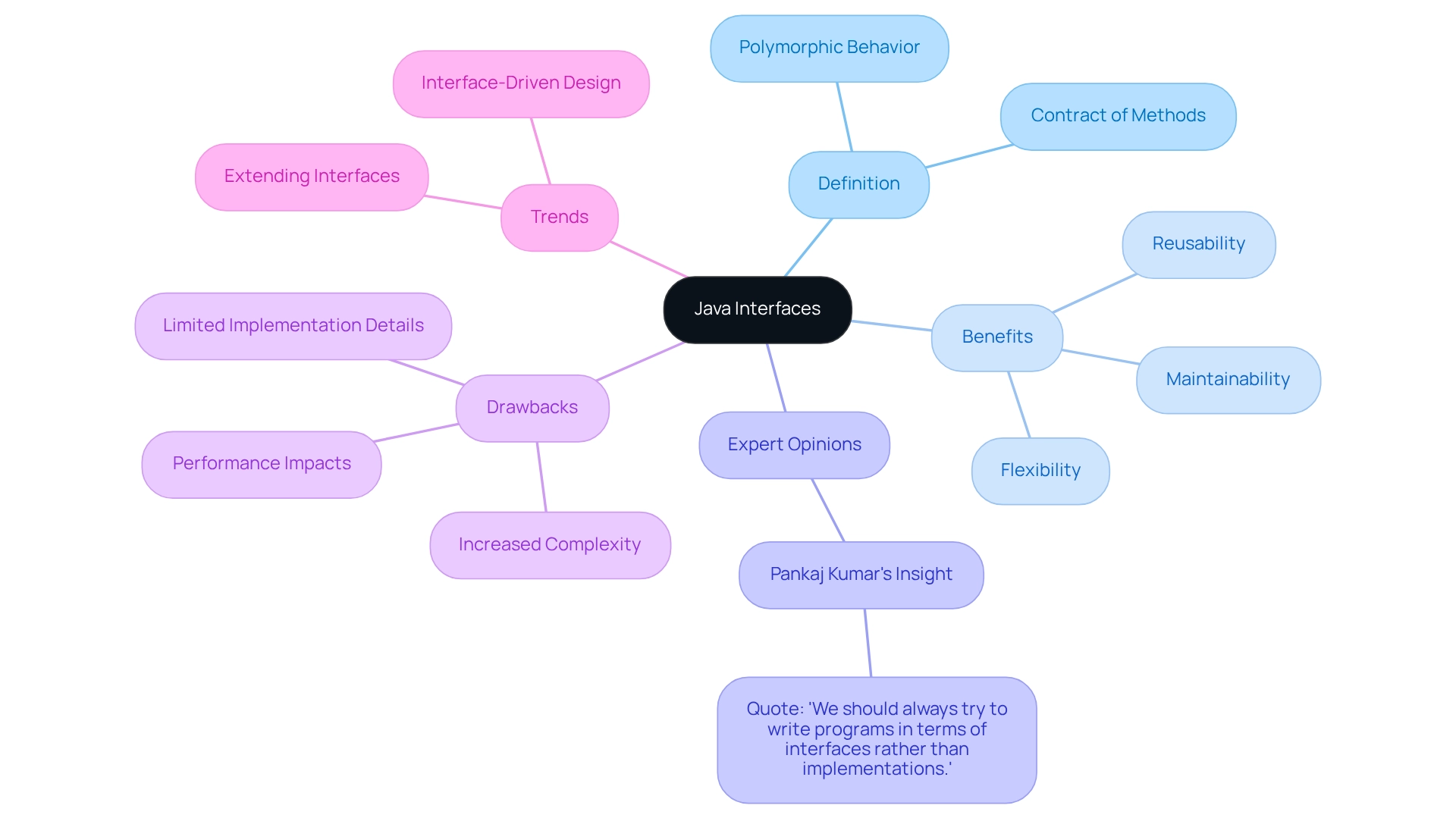
Relationships in OOP: Association, Aggregation, and Composition Explained
In the realm of programming, developers often encounter challenges related to structuring their code effectively. Understanding the relationships between entities in Object-Oriented Programming (OOP) is crucial for mastering OOP features in Java and overcoming these hurdles. There are three main types of relationships:
- Association signifies a loose connection between types, where one type utilizes another.
- Aggregation, on the other hand, represents a 'whole-part' relationship, indicating that one entity can contain references to another, yet both can exist independently.
- Conversely, composition illustrates a more robust relationship, wherein the lifecycle of the contained entity is dependent on the lifecycle of the container entity.
Grasping these relationships is essential for creating well-structured and maintainable code, particularly when applying OOP features in Java. By leveraging these concepts, developers can enhance their coding practices, leading to improved productivity and code quality. So, why not explore how these foundational principles can transform your coding approach?

Access Modifiers: Controlling Visibility and Security in Java OOP
Access modifiers in Java play a crucial role in addressing the coding challenges developers face regarding data visibility and security. These modifiers—public, private, protected, and default (package-private)—allow developers to encapsulate data effectively, protecting it from unauthorized access.
For example, when a variable is marked as private, it cannot be accessed directly from outside the class, which promotes better security and reduces the risk of unintended modifications.
Understanding and applying access modifiers is essential for maintaining clean and secure code, ultimately leading to improved productivity and code quality.
Are you leveraging these tools in your coding practices?

Conclusion
In the world of software development, the challenges developers face are ever-increasing. Integrating the principles of object-oriented programming (OOP) is essential for creating efficient, maintainable, and high-quality applications. Key concepts such as encapsulation, inheritance, polymorphism, and abstraction provide a framework that enhances code organization and reusability. By leveraging these principles, developers can tackle the complexities of modern coding environments more effectively.
Furthermore, the use of tools like Kodezi can significantly streamline the development process. Kodezi automates documentation and improves productivity with features that enhance code quality and facilitate adherence to professional standards. This empowers developers to focus on what truly matters: writing robust and efficient code. With productivity improvements of up to 30%, the value of such tools in today's fast-paced software landscape is undeniable.
In addition, embracing OOP principles and utilizing advanced tools like Kodezi fosters better coding practices while supporting developers in creating scalable, maintainable systems. As the software development field continues to evolve, adopting these practices will be crucial for staying competitive. By prioritizing OOP and leveraging innovative solutions, developers can navigate the complexities of modern software development with confidence and ease.
Are you ready to enhance your coding practices? Explore the tools available on the Kodezi platform and discover how they can transform your development experience.
Frequently Asked Questions
What is Kodezi and how does it assist programmers?
Kodezi is an innovative solution designed to streamline the management of Object-Oriented Programming (OOP) features in Java. It includes a Professional OpenAPI Specification Generator that automates the creation of standardized API documentation, allowing programmers to focus more on coding and enhancing overall productivity.
How does Kodezi improve productivity for developers?
By integrating Kodezi into their workflow, developers can automate documentation tasks, which can boost programmer productivity by up to 30%. This allows them to maintain high-quality code while reducing the time spent on documentation.
What role does encapsulation play in Java programming?
Encapsulation is a fundamental principle in Java that involves bundling data and methods within a single unit, typically a class, to restrict direct access to certain components. This practice enhances security by safeguarding sensitive information and improves maintainability by reducing dependencies between components.
Why is encapsulation becoming increasingly important for developers?
The significance of encapsulation is growing as it enhances code quality and security. Organizations that prioritize encapsulation report reduced vulnerabilities in their software, which is crucial in the context of rising data breaches and security threats.
What are some best practices for implementing data encapsulation in Java?
Best practices for implementing data encapsulation include defining clear interfaces for data access and modification, utilizing getter and setter methods, and regularly reviewing access modifiers to align with evolving security standards.
How does inheritance benefit Java developers?
Inheritance allows a new entity (subclass) to acquire attributes and behaviors from an existing entity (superclass), which streamlines the development process by reducing redundancy and enhancing code organization. This facilitates easier management and expansion of applications.
What statistics highlight the importance of inheritance in programming?
Statistics indicate that roughly 10% of applications with adequate components exhibit cycles involving at least 1,000 elements, emphasizing the complexity that can arise without effective inheritance. Additionally, expert insights show that leveraging inheritance accelerates development and fosters a cleaner codebase.
What are the implications of efficient inheritance strategies in Java?
Efficient inheritance strategies enhance resource utilization in programming. For instance, it has been observed that only around 50% of the classes in the Standard API are utilized, and approximately 21% of methods are employed, highlighting the need for effective inheritance practices to improve application architecture and reuse.




